#irwin silber
Text

Harry Smith - Sing Out! on WBAI with Barbara Dane & Irwin Silber, April 1965
A feisty / folky hour of radio from way back in 1965. I've been immersed in the Harry Smith universe for a couple months now, thanks to John Szwed's remarkable bio Cosmic Scholar, which I followed up quickly with Paolo Igliori's American Magus. Obviously, Smith is fascinating character — and the Anthology of American Folk Music is just the tip of the iceberg.
The Anthology, however, is the main topic of discussion on the Sing Out! show, which Harry seems bemused/amused by; he had put the whole thing together well over a decade before and had definitely moved on to other things. But Smith must've been pleased that as the 1960s kicked into high gear, his collection of oddball vernacular folk was proving to be deeply influential.
While listening to Harry spar (playfully, mostly) with Irwin and Barbara here, I kept trying to think who his voice reminded me of — and then I realized ... it was a guy who knew the Anthology backwards and forwards: Jerry Garcia.
21 notes
·
View notes
Text
Anthology V2 source photo
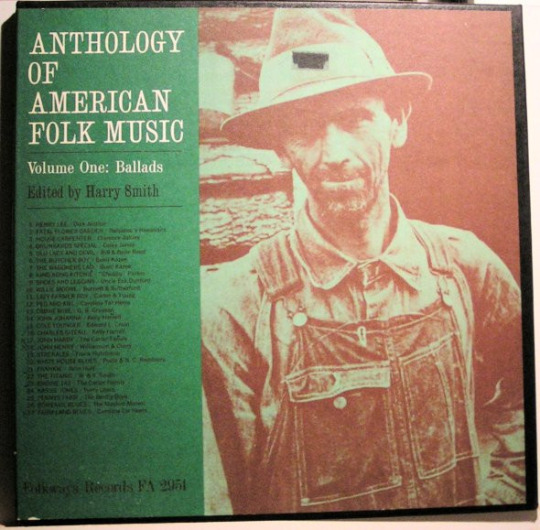
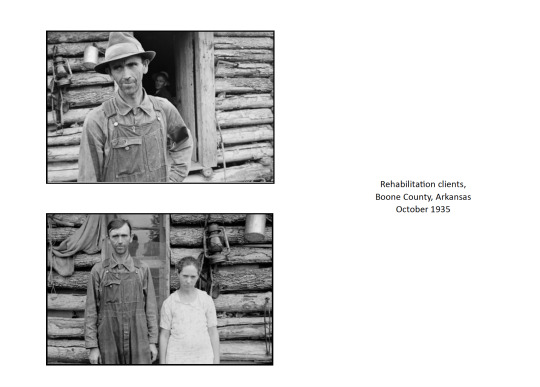
Today, I found the original source of the cover image of the 60's reissue of the Anthology of American Folk Music (+ an alt). Irwin Silber wanted this depression-era farmer on the cover, Harry Smith objected but was overruled. Photo by Ben Shahn in '35, Arkansas. Here's why he took it...
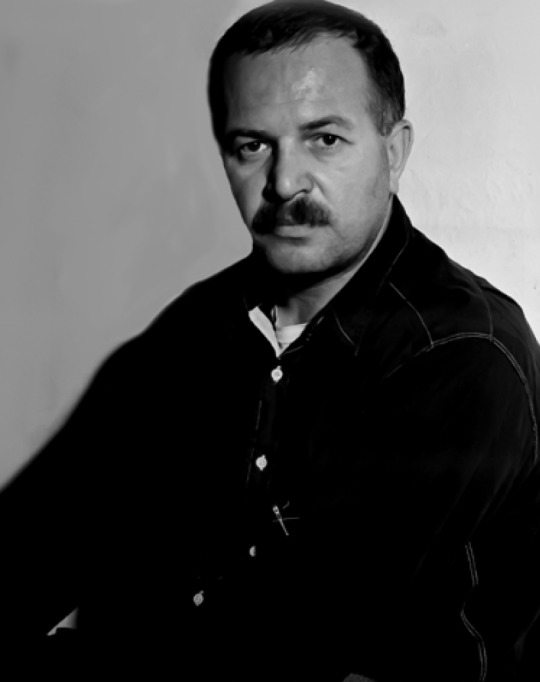
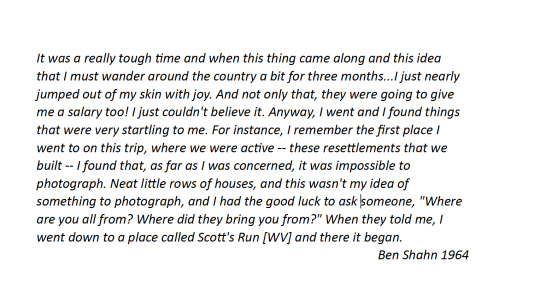
Here's more photos he took while he had the Resettlement Admin. job. (top, bottom) Pensylvania, 1937, North Carolina, 1937


Natchez, Mississippi 1935
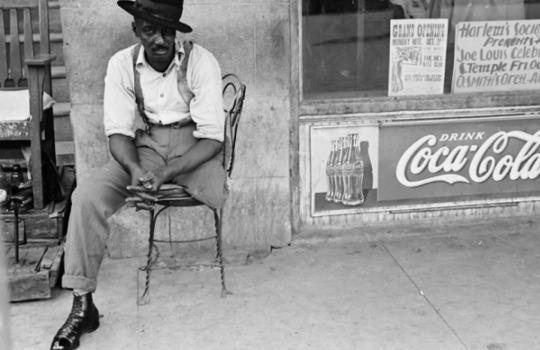
Amite City, Louisiana, 1935.
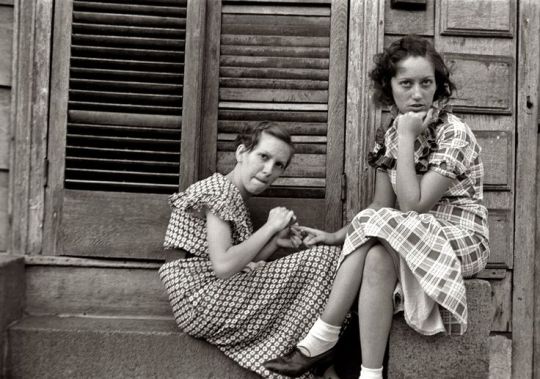
Arkansas, 1935
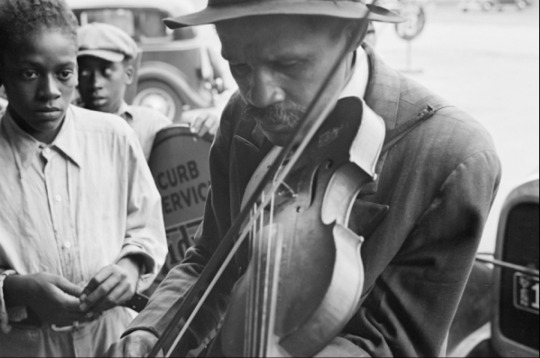
The 1997 Smithsonian reissue restored Harry Smith's vision, although, in hindsight, the Shahn image had helped sales by linking the set to a protest movement and fueling the peak of the folk music revival in the 1960's.
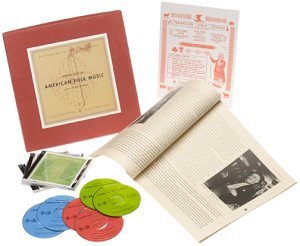

(source of above excerpt)
5 notes
·
View notes
Text
youtube
We Say No to Your War - Covered Wagon Musicians
A "GI movement" anti-war record from 1972 (Paredon Records # P-1015), released on the label founded by Barbara Dane and Irwin Silber - all the songs were written and sung by active-duty GIs at the Mountain Home Air Force Base, Idaho. The group, formed in the spring of 1971, started their own publication called "Helping Hand".
The song "We Say No to Your War" recalled the group marching from Mountain Home AFB to Boise, Idaho, in August 1971 to mark the anniversary of the bombing of Hiroshima and Nagasaki. As suggested by the title, it stated its opposition to Vietnam. Note the reference to napalm and Nixon.
6 notes
·
View notes
Text
NEWYou can now hearken to Fox News articles!
New York Rangers defenseman Ryan Lindgren missed three video games within the first-round collection towards the Pittsburgh Penguins within the Stanley Cup playoffs however made all of the distinction when he returned.Lindgren suffered a lower-body harm in Game 1 of the collection and missed Games 2-4. The Rangers misplaced Game 1 in extra time and managed to win Game 2 earlier than shedding Games 3 and 4 by a purpose differential of minus-7. CLICK HERE FOR MORE SPORTS COVERAGE ON FOXNEWS.COM
New York Rangers defenseman Ryan Lindgren towards the Pittsburgh Penguins on May 11, 2022, at Madison Square Garden in New York City.
(Rich Graessle/Icon Sportswire through Getty Images)In his return in Game 5, Lindgren scored an empty-net purpose to seal the win and preserve New York’s playoff possibilities alive. He would decide up a degree on an help to Mika Zibanejad in Game 6 because the Rangers shocked the Penguins on the highway 5-3. He would end plus-1 within the deciding Game 7 win.Throughout the collection, Lindgren’s teammates praised the defenseman’s efforts and underscored simply how vital he's to the group."That’s simply the form of participant he's," Chris Kreider stated of Lindgren’s efficiency in Game 5, through the New York Post. "That’s simply how he’s constructed. I don’t assume we anticipated something much less, however on the identical time, I feel the correct phrase is inspiring. He’s a warrior. He’s the form of man that you simply need to be in a foxhole with you.
Ryan Lindgren of the New York Rangers strains up for a face-off within the Stanley Cup Playoffs towards the Penguins on May 13, 2022, in Pittsburgh, Pennsylvania.
(Kirk Irwin/Getty Images)RANGERS' HISTORIC STANLEY CUP PLAYOFF FEAT AGAINST PENGUINS UNDERSCORES RESILIENCY"You know, it was terrific to get him again within the lineup and to see him play the way in which he did. He’s an enormous a part of this group. Huge half, I imply, on the ice and within the locker room."Lindgren’s empty-net purpose was the primary of his playoff profession.New York acquired the younger defenseman within the Rick Nash commerce with the Boston Bruins in 2018. He’s simply one of many Rangers’ acquisitions who've paid dividends within the collection.
Mika Zibanejad of the New York Rangers smiles after a 4-3 extra time win towards the Pittsburgh Penguins within the Stanley Cup playoffs at Madison Square Garden on May 15, 2022, in New York City.
(Jared Silber/NHLI through Getty Images)Artemi Panarin, the extremely touted signing from the Columbus Blue Jackets a number of years in the past, scored the game-winning purpose in Game 7 to push previous the Penguins. Zibanejad was acquired by the Ottawa Senators for a draft decide and Darick Brassard. The group acquired Jacob Trouba from the Winnipeg Jets in 2019.CLICK HERE TO GET THE FOX NEWS APPAll 4 gamers had been amongst those that contributed to the collection win over the Penguins.
0 notes
Link
In 1973, three young activists in New York City recorded A Grain of Sand: Music for the Struggle by Asians in America. Singing of their direct lineage to immigrant workers as well as their affinity with freedom fighters everywhere, Chris Kando Iijima, Nobuko JoAnne Miyamoto, and William “Charlie” Chin recorded the experiences of the first generation to identify with the term and concept Asian American—a pan-ethnic association formulated upon a shared history of discrimination. They sought a connection to their cultural heritage; to claim their historical presence in the United States; to resist their marginalization; and to mobilize solidarity across class, ethnic, racial, and national differences. Music provided a powerful means for expressing their aspiration to reshape a society reeling from a prolonged war, ongoing struggles against racial inequity, and revelations of the Watergate cover-up. As writer and activist Phil Tajitsu Nash would state many decades later, A Grain of Sand was “more than just grooves on a piece of vinyl,” it was “the soundtrack for the political and personal awareness taking place in their lives.” Equal parts political manifesto, collaborative art project, and organizing tool, it is widely recognized as the first album of Asian American music.
A Grain of Sand was produced by Paredon Records. Over the course of 15 years, Paredon founders Irwin Silber and Barbara Dane amassed a catalog of 50 titles reflecting their commitment to the music of peace and social justice movements. In 1991, to ensure its ongoing accessibility, Silber and Dane donated the Paredon catalog to the Ralph Rinzler Folklife Archives and Collections at the Smithsonian Center for Folklife and Cultural Heritage, through which these recordings and their original liner notes remain available to the public.
THE MUSIC
While the message of the album was by no means mainstream, the music through which Chris, Nobuko, and Charlie expressed their political and social convictions was reflective of the popular genres of the period. The 12 songs on A Grain of Sand were shaped by the American folk music revival, blues, soul, and jazz. For instance, “The Wandering Chinaman” is in the form of a traditional ballad. “We Are the Children” is more of a folk-rock anthem. “Divide and Conquer” and “Free the Land,” with their bass and percussion lines, are driven by a soul groove. “Something About Me Today” and “War of the Flea,” are instrumentally stark, emphasizing Nobuko’s voice against the counterpoint of Chris and Charlie’s guitar lines. All of their songs are notably written in the first person and directly encourage the listener to
action: “Hold the banner high...”; “Will you answer...”;
“Take a stand....”
Intending to take their music on the road, they kept their instrumentation simple—two guitars and three voices. For the album and in some performances, they were backed by conga and bass, and other instruments such as the di zi, a Chinese transverse flute that Charlie played.
A Grain of Sand was mostly compiled over a two-day period from first or second takes. Charlie compares their 4-track recording process to more technically sophisticated commercial productions as the difference between “a folding chair and a Maserati.” And perhaps because of these conditions, the recording is animated by the spontaneity and energy of a live performance. Arlan Huang, who created the artwork for the album jacket, remembers, “It was fresh as can be. There was nothing else like it. The power of their lyrics was aimed at people like me. They were saying things that I had thought about but hadn’t put into words or painting. And they were GOOD. It wasn’t like seeing your buddies at the neighborhood hootenanny strumming a guitar. Nobuko could actually sing.”
THE ARTISTS
Chris, Nobuko, and Charlie, who were in their twenties and thirties in the early 1970s, arrived at their collaboration via routes that reflect the legacies of migration and exclusion.
Nobuko JoAnne Miyamoto (b. 1939). Nobuko’s mother was born in the United States, the daughter of Japanese immigrants; her father was the son of a Japanese immigrant father and a White Mormon mother from Idaho. The family was living in Los Angeles when World War II broke out and all people of Japanese ancestry on the West Coast were forcibly removed from their communities. To get his family out of the Santa Anita racetrack where they were initially confined, Nobuko’s father volunteered to harvest sugar beets in Montana. From there the family moved to Idaho and then to Utah before they were allowed to return to Los Angeles after the war. Despite this instability, Nobuko was encouraged by both parents in her study of music and dance. By the 1960s, she had been a scholarship student at the American School of Dance in Hollywood; performed with Alicia Alonso’s ballet company; and performed in the original Broadway production of Flower Drum Song, as well as in the film adaptation of West Side Story, where she was cast as one of Maria’s Puerto Rican dress-shop companions. She had also discovered the limitations of being an Asian in the mainstream entertainment industry. In 1968, she helped Italian filmmaker Antonello Branca to document the Black Panther Party for his film Seize the Time. Through this project, she met Yuri Kochiyama, a Harlem community activist and friend of the late Malcolm X, who subsequently introduced Nobuko to civil rights organizing in the local Asian and African American communities.
Chris Kando Iijima (1948–2005). Both of Chris’s parents, Americans of Japanese ancestry, were originally from California but raised their family in New York City, where they resettled after their World War II incarceration. Their example and consciousness significantly contributed to A Grain of Sand. Chris’s father was a musician and choirmaster, who took his children to the 1963 March on Washington. His mother—inspired by the educational and cultural activities integral to the Black Power movement—co-founded the organization Asian Americans for Action (Triple A) in 1969 to instill the same kind of pride in local Asian American youth. Chris attended the High School of Music and Art in Harlem, where he studied French horn, though he also played guitar.
Chris and Nobuko met in Triple A; and they wrote their first song and performed together in 1969 at a conference of the Japanese American Citizens League, where they joined other young people in urging the organization to oppose the war in Vietnam. Nobuko recalls, “We sang a song that was the collective expression of our Asian brothers and sisters to stop the killing of people who looked like us. The electricity of that moment, the realization that, until then, we had never heard songs about us, set the course of my journey.” When they returned to New York, Chris and Nobuko wrote more songs and began to perform locally and in California. A year later they met Charlie Chin.
William “Charlie” Chin (b. 1944). Charlie’s father came to New York City from Toisan, China; his mother, who was of mixed Chinese, Carib, and Venezuelan ancestry, was born in New York but raised in Trinidad. Growing up in Queens, Charlie’s musical upbringing was comprised of the Trinidadian forms played by his mother’s relatives and those emanating from the American folk music revival. Inspired by Pete Seeger, Charlie took up the banjo, but he also played cuatro, auto harp, and guitar. In the late 1960s, he toured the country with Cat Mother and the All Night News Boys. After he left the group, he returned to New York, where he worked as a bartender. In 1970, he ended up backing Chris and Nobuko by chance at a performance for a conference of new Asian American community groups, student organizations, and activists at Pace College. He recalls, “I’m at the conference, and all the things they are talking about—Asian Americans, how history impacts us, how we have been apologetic about being Asian. And there’s been this hanging question for me, ever since I had taught Appalachian 5-string banjo at a folk music camp, ‘Where is my history? Where is my culture?’ So I go on with them. And I’m listening—I have never heard this stuff before. This is amazing. So the first time I ever hear them play, I’m playing with them.”
For the next three years, the trio performed at Buddhist temples, churches, colleges, community centers, coffeehouses, rallies, prisons, and parks in New York and across the country. “We became like griots,” Nobuko says, “Moving like troubadours from community to community—we’d say, ‘This is what is going on in New York…and we have this Chinatown health program going on,’ and we would carry this news to Sacramento and L.A. and Stockton and San Francisco. And then we’d gather stories from there and carry it back to New York. We were like the YouTube of the times—spreading the news.”
THE MOVEMENT
Coming of age during the civil rights and anti-war movements, the children and grandchildren of Asian immigrants unleashed a whirlwind of grassroots activism beginning in the late 1960s. Around the country, they protested the war. They demanded ethnic studies curricula. They organized against urban renewal projects that displaced the residents of old Chinatowns and Japantowns. They formed literary workshops, art collectives, and social service centers. A Grain of Sand was a direct extension of Chris, Nobuko, and Charlie’s collaboration in the Asian American Movement.
One important community that provided support and inspiration for A Grain of Sand was Basement Workshop, an Asian American collective in New York’s Chinatown. Formed in 1970, they ran a creative arts program, a resource center for community documentation, and a youth employment program; produced a magazine; and offered language and citizenship classes. In 1971, Basement Workshop undertook a project to illustrate and publish the music of Chris, Nobuko, and Charlie. Titled Yellow Pearl, after one of their songs, it grew into a larger compilation of writing, art, and music. Public artist Tomie Arai emphasizes the importance of Basement and A Grain of Sand during this period: “You have to understand. There wasn’t anything at all out there. There was no music. No published poetry, music, recordings. Nothing. It was through Basement that people began to refer to themselves as artists. I didn’t know any artists. I wanted to be one—but I didn’t know what that meant.”
Fay Chiang, who served as director of Basement for 12 years, recalls that for their programs and direct actions, they also looked to the examples of other communities: “We were influenced by what was happening in the Black and Puerto Rican communities. Why not us? Who are we? It was very basic: Who are we? There was a hunger, a need to figure that out, where we felt like it was a matter life and death. The second and third generation Japanese Americans had come from the camps—and this feeling of not belonging in the society, racism, and displacement was visceral.”
Chris, Nobuko, and Charlie’s association with activists in other communities was reflected in their music. For example, “Somos Asiaticos” was inspired by their involvement with squatters’ organizations Operation Move In and El Comité. These activists opened a coffee shop on Manhattan’s Upper West Side, the Dot, which was regularly visited by singers, performers, and poets from Cuba, Chile, Peru, Puerto Rico, and the Dominican Republic. The Asian Americans who had taken over a storefront for a drop-in center down the street also congregated here. Nobuko recalled, “We were all there—artists and poets—listening to and influencing each other. We had a whole set, five songs, that we did in Spanish. One year, I think it was 1973–1974, we did more gigs for Latino groups than for Asian groups.” In fact, their first recording was done for a Puerto Rican company, Discos Coqui. Invited by two Puerto Rican Movement singers, Pepe y Flora, they recorded “Venceremos” and “Somos Asiaticos,” which were released as a 45 disc in Puerto Rico. Later, they were invited to perform at Madison Square Garden for Puerto Rican Liberation Day.
“Free the Land,” another song on A Grain of Sand, was written by Chris for the Republic of New Africa. This organization, established by a group of Malcolm X’s associates after his 1965 assassination, was the first group to call for slavery reparations—in particular in the form of an all-Black homeland in the southern states of Mississippi, Alabama, Georgia, Louisiana, and South Carolina. Atallah Muhammad Ayubbi and Dr. Mutulu Shakur, both Republic of New Africa members, performed on A Grain of Sand. Atallah worked in the Black and Puerto Rican communities in the Bronx where he grew up. He was also a conguero and sometimes accompanied the group in live performances. Dr. Mutulu Shakur, who is the godfather of Nobuko and Atallah’s son, provided background vocals on the album. He often played the album at home, and his stepson, the late rapper Tupac Shakur, grew up listening and singing along to it.
Of this time in the early 1970s, Nobuko recalls, “It was like jumping into the pool of revolution…. Every day there was organizing going on at many different levels. It was powerful. You see something wrong, you have an idea how to fix it, you put it into practice.” And about this period living on the Upper West Side, she says, “that was the first time I ever felt like I was part of a community. You would walk down the street and see people you knew, and they would ask if you were going to be at such-and-such event and could you bring food or perform. It was a dynamic moment. We were crossing borderlines, and the music helped us to do that.”
THE LEGACY
The intensity of purpose and activity during this period succeed in reshaping academic, cultural, and political institutions. It also gave rise to ideological conflicts and violence that sometimes destabilized organizations and efforts. For instance, Basement Workshop was shaken internally by the accusations and criticisms of members of the Communist Workers Party. And several months after A Grain of Sand was recorded, Atallah was killed in an ambush at a Brooklyn mosque.
Charlie remembers, “We were all moving so rapidly…. Everyone believed that things could be changed if you worked on it. We in our very young innocence thought that there actually would be a revolution in this country. I assured people it would happen. And when it didn’t, I felt bad: ‘Sorry, man’, ‘Sorry, dude.’”
By late 1973 when A Grain of Sand was released, Chris, Nobuko, and Charlie were beginning to hone their sense of purpose in ways that drew them in different directions. And the album marks, in effect, one of the group’s final collective efforts, though each in their own way continued the work they had started together.
Nobuko returned to southern California. In 1978, she established the organization Great Leap, Inc., through which she initiates multicultural community performing arts collaborations in Los Angeles, as well as nationally and internationally. She continues to perform, lecture, and provide workshops based on her new music as well as on reinterpretations of the songs from A Grain of Sand. In recent years her residencies and special projects have focused on facilitating dialog across spiritual differences and on environmental issues. Active in the Senshin Buddhist Temple, she has composed music and dances that are now a regular part of the annual Buddhist observance of obon (Festival of Lanterns) in temples from California’s Central Valley to San Diego and nationally.
Charlie focused his attention in New York’s Chinatown, becoming involved in the Chinatown History Project, which became the Museum of Chinese in the Americas. He later apprenticed to a master Chinese storyteller, learning the traditional teahouse style, which he has adapted and continues to perform throughout the country. In 1991, he moved to northern California, and he now works for the Chinese Historical Society of America in San Francisco, driven by the conviction that “we know that people can be whipped into hysteria and xenophobia—we’ve seen it happen before, and it could happen again. And the only thing you can do is be vigilant and educate, educate, educate.”
Chris directed his energies to New York’s Upper West Side, where he had grown up. After 10 years of classroom teaching at Manhattan Country School, he studied and practiced law, and later became a professor in Hawai`i, where he fought for Native Hawaiian rights and mentored a generation of social justice–minded law students. He passed away in 2005 at the age of 57.
In the years just before Chris’s passing, Tadashi Nakamura, a young fourth-generation Japanese American filmmaker, began producing a documentary about him, A Song for Ourselves: A Personal Journey into the Life and Music of Asian American Movement Troubadour Chris Iijima. His film is an inspiring and melancholy portrait of Chris, covering his participation in A Grain of Sand, his reflection on his life as he confronted terminal illness, and the impact he had on others. For the film’s premiere in 2009, Nakamura invited Nobuko and Charlie to perform—and he also enlisted several young hip-hop artists. He explains: “Grain of Sand paved the way for many progressive Asian Americans and Pacific Islanders [API] to not only become musicians but cultural workers—artists who use their creativity to further a political movement. I feel very much a part of a present-day movement of API artists that are trying to document, articulate, and tell the stories of their people through their work. A talented new set of artists—such as Geologic and Sabzi of Blue Scholars, Kiwi, Bambu and DJ Phatrick—are creating the soundtrack to my generation’s movement. They are continuing the work that Chris, Nobuko, and Charlie started back in the 1960s. So when I premiered my film, I invited them to perform. I wanted to show that the legacy of A Grain of Sand is very much alive today.”
#A Grain of Sand: Music for the Struggle by Asians in America#Asian American#Chris Kando Iijima#Nobuko JoAnne Miyamoto#William “Charlie” Chin
13 notes
·
View notes
Photo
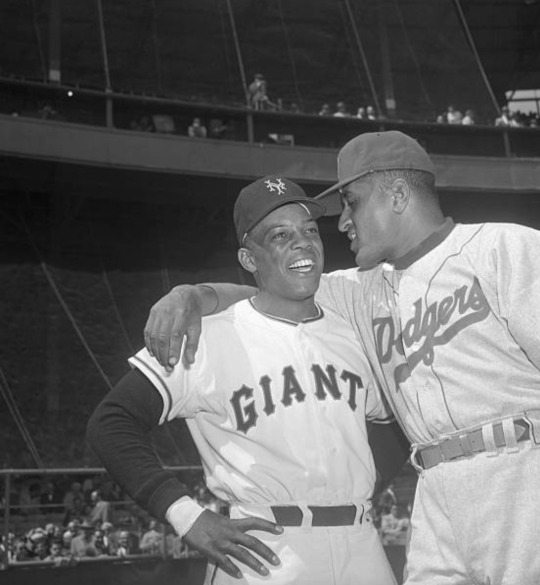
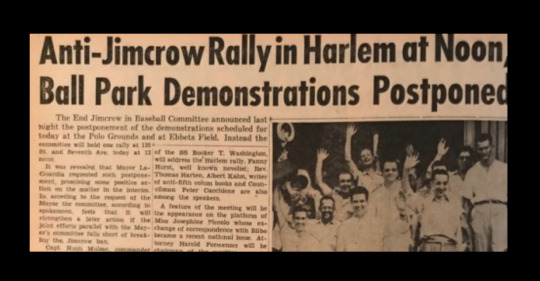
The integration of Major League Baseball was opposed by ball club owners, team managers, and sports writers throughout the 1930s and 40s. They bent over backwards to justify segregation.
The Sporting News said Jackie Robinson was not worthy enough for the worst all-white C-league team, arguing, “There is not a single [Black] player with major league possibilities.” The New York World Telegram agreed: “Blacks have been kept out of big-league ball because they are, as a race, very poor ball players.”
A couple years later when the overwhelming talent of African-American ballplayers in the Negro Leagues became obvious to the general public, The Sporting News justified segregation on humanitarian grounds: “The use of mixed teams in baseball would benefit neither the Negro nor white professional game because of the possibility of unpleasant incidents.”
Several major league owners opposed integration because they believed it bring more Black fans into the stands, which they claimed would plummet the financial value of their teams. “The percentage of Negro attendance at some [minor league] games at Newark and Baltimore was in excess of 50%,” wrote Larry MacPhail, president of the New York Yankees. “A situation might be presented, if Negroes participate in Major League games, in which the preponderance of Negro attendance in parks such as Yankee Stadium, the Polo Grounds and Comiskey Park could conceivably threaten the value of Major League franchises owned by these clubs.”
Sports writer Lester Rodney said Yankee broadcaster Mel Allen "was an apologist for the Yankees being lily-white for so long ... he wasn’t going to rock the boat.” He also recalled the blatant racism of its management. “The Yankees top management had some real sons-of-bitches. George Weiss, the general manager, was an out and out racist. Every sportswriter knew it. When he was asked, ‘How about the Yankees getting a colored ball player?’ he said, ‘You really want one of them in our pinstripes?”
The Boston Red Sox reluctantly agreed to give three Black players tryouts in 1945 after having been pressured to do so by the Boston City Council. One of them was Jackie Robinson. Red Sox scout Hugh Duffy was impressed, but said, “Too bad he’s the wrong color.”
Players like Dixie Walker of the Brooklyn Dodgers said the push to integrate Major League Baseball was a Communist conspiracy. It was true that the media arm of the CPUSA, The Daily Worker, was the primary advocate for breaking the color barrier and there is a consensus that the advocacy of the Communist Party is the reason Major League Baseball was eventually integrated. “It’s the commies who want to break down the lines,” complained Walker as he passed an anti-Robinson petition through the Brooklyn dugout.
Integrated baseball was also opposed by owners in the Negro Leagues. Journalist Irwin Silber explained, “A good number of Negro League team owners – many of whom were white – likewise opposed integration, because it would obviously undermine their own business interests.”
76 notes
·
View notes
Text
Meet Barbara Dane and Her Proud Tradition of Singing Truth to Power
https://sciencespies.com/history/meet-barbara-dane-and-her-proud-tradition-of-singing-truth-to-power/
Meet Barbara Dane and Her Proud Tradition of Singing Truth to Power

Smithsonian Voices Smithsonian Center For Folklife & Cultural Heritage
How Barbara Dane Carries a Proud Tradition of Singing Truth to Power
March 8th, 2021, 12:00AM
/ BY
Theodore S. Gonzalves
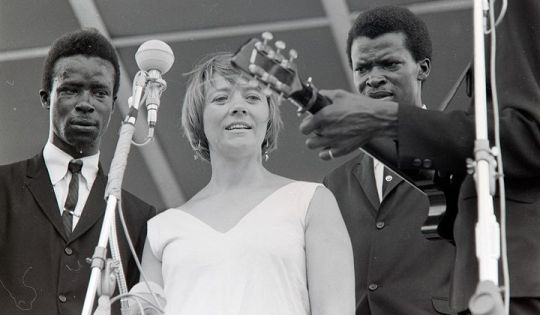
Barbara Dane with the Chambers Brothers at the 1965 Newport Folk Festival. (Photo by Diana Davies, Ralph Rinzler Folklife Archives)
There are times when a songwriter, a song, and a moment come together to make an impact beyond anyone’s expectations. That’s precisely what happened when Los Angeles-based songwriter Connie Kim (on stage, she’s MILCK) performed “Quiet” during the Women’s March in Washington, D.C, on January 21, 2017.
Originally written a year before the march with Adrian Gonzalez to address Kim’s personal trauma from an abusive relationship, they turned pain into power: “I can’t keep quiet / A one-woman riot.” A year later, the song served a wider purpose and a much larger audience.
Starting with smaller groups of women singing a cappella in different locations throughout the country, and without the benefit of in-person, live rehearsals, Kim found herself on the National Mall. She’s heard of choirs in Ghana, Sweden, Australia, Philadelphia, New York City, and Los Angeles singing “Quiet.” Her “one-woman riot��� grew to millions: “Let it out now / There’ll be someone who understands.”
Kim concedes, “It’s not my song. It’s our song.”
Today on International Women’s Day, it’s time to connect the newest generation of songwriters like MILCK to a long and proud tradition of singing truth to power.
Since the 2016 presidential election, millions of people have found themselves in the streets, holding signs, chanting, singing, occasionally braving inclement weather, and probably meeting others they never expected to know. “I never thought I’d be out here, for hours,” many have said, some taking to protest for the first time in their lives. Maybe it was what was said on the campaign trail, how it was said, or simply who was saying it. For all the first-timers out there, no matter how they feel about the politics of the day, people finding connection in the streets should know that singer-agitator Barbara Dane has been connecting audiences and marchers for years, decades even.
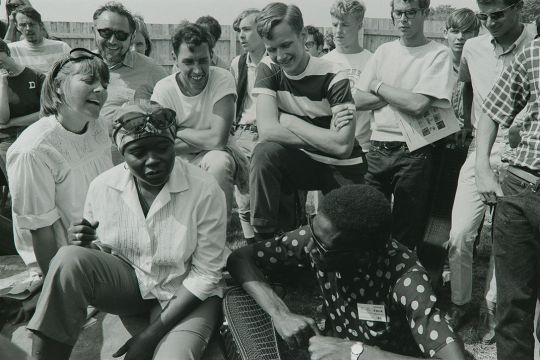
Barbara Dane (left) at the 1966 Newport Folk Festival. (Photo by Diana Davies, Ralph Rinzler Folklife Archives)
As a teen, Dane sang for striking autoworkers in her hometown of Detroit. She attended the Prague Youth Festival in 1947 and connected local protest with stories of young people from around the world. With a natural gift for swinging and singing the blues, she launched a career in jazz that caught the attention of some of the greatest on the scene, like Louis Armstrong. By the end of the 1950s, Dane was featured in Ebony magazine, the first white woman to be featured in those pages and photographed with blues greats.
Forget about the sublime images of suburban life on TV from the 1950s. The postwar years saw millions taking up the banner of decolonization and national liberation. Americans couldn’t ignore those tides and neither could Barbara Dane. Her protest music took her to Mississippi Freedom Schools, free speech rallies at UC Berkeley, and in the coffeehouses where active-duty men and women steered clear of military police and regulations forbidding protests on bases. Dane was seemingly everywhere, leading chants, reinterpreting songs by Woody Guthrie, Pete Seeger, and Sara Ogan Gunning.
By the late 1960s, Dane took up an invitation to visit Cuba, where she was greeted warmly. Did she care about the U.S. State Department’s admonition against making the visit? Her response was sharp and clear: “We’re a country that promotes freedom, so why can’t this free person go where she wants to go?”
It’s no accident that Dane found kindred spirits among the ranks of singers and songwriters working in the nueva canción genre. This was a popular music that celebrated a constellation of impulses and influences, ranging from local, indigenous, folk, and ethnic instrumentation, stylizing, and vocalizing, to lyrics that were political, socially aware, defiant, or even comedic at times. Her Havana trip not only gave her a strong anchor in nueva canción for reference, but she also found singer-songwriters from Europe and Asia who shared those passions and interests.
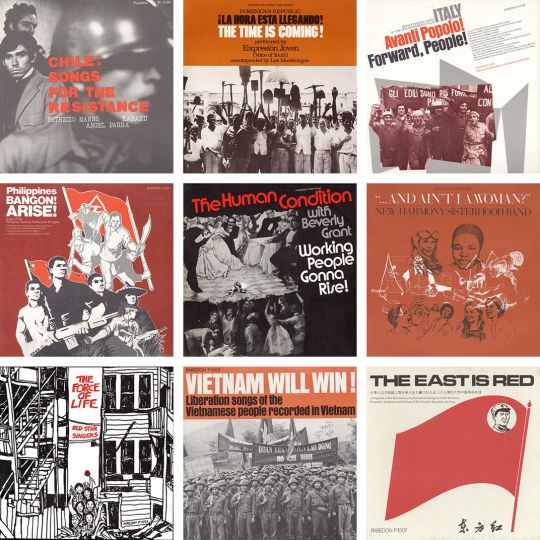
Album art from Paredon Records (Ralph Rinzler Folklife Archives)
These connections formed the basis of Paredon Records, the recording label she founded with Irwin Silber, a skilled critic and record producer. From 1970 to 1985, Dane and Silber released fifty albums that documented protest music from around the world. The musical messages reflected the stakes and the hopeful dreams of millions trying to make sense of a world dominated by superpowers with world-ending weaponry.
The songs and the writers came from every corner: students from Thailand and the Dominican Republic. Activists from Chile. Mass-party workers from the Philippines and Italy. Working-class rock by Brooklynite Bev Grant, anti-imperialist folk by Berkeley’s Red Star Singers, and anti-patriarchal songs by the New Harmony Sisterhood Band. But don’t think you can reduce Dane’s Paredon collection to merely strident messaging.
Throughout the catalog, you feel Dane’s attention to what it can mean to link the songwriter, the song, and the moment into something soulful and personal. Many of the musicians featured on Paredon trusted Dane because she was also an experienced singer in addition to being the label’s co-founder, writer of dozens of liner notes, and producer. She had the practical experience of knowing life as a working musician in an industry and in social movements dominated by men. She more than held her own. Audiences trusted her politics and attitude. And fellow musicians heard in Dane’s voice the hard life of singing for your living.
Getting out on the road and performing kept her vital and engaged. For Dane, as she explained in the liner notes to Barbara Dane Sings the Blues, the road taught her
what it means to be alive, to value life above anything and rage like a tiger to keep it… to spend it with care instead of trading it for a new car or a fur coat… to treasure the moments that are real between human beings without counting the cost or trying to bargain, because there’s no price on that beauty. The only thing we have, really, is our time alive, and I don’t think they’ve printed enough to buy mine. How about yours?

Folk musician Len Chandler talks with Barbara Dane at a major rally for the Poor People’s Campaign in Washington, D.C., 1968. (Photo by Diana Davies, Ralph Rinzler Folklife Archives)
It’s not too late for MILCK to meet up with Dane. I had the chance to catch Dane’s eighty-fifth birthday concert, where she sold out the Freight and Salvage in Berkeley, California. For the first set, her quintet backed her as she delivered a slate of jazz and blues standards. After the intermission, members of her family performed—her daughter, Nina, singing flamenco; her two sons, Jesse and Pablo, and her grandson on guitar. Toward the very end of the evening, she brought up her entire family, spanning four generations, and had her great-granddaughter step up to the mic to sing.
It was getting late into the evening, and I was going to miss my train back into the city. I left just as Dane led the crowd through chorus after rousing chorus of “We Shall Not Be Moved.” I could hear her strong voice fade as I hit the street and descended into the subway station.
I hope MILCK gets a chance to see Dane, now ninety, perform live. Or maybe they could teach each other their favorite songs. Both of them, so much more than a one-woman riot.
youtube
Above, watch Barbara Dane sing and share stories during the 2020 Smithsonian Folklife Festival’s Sisterfire SongTalk.
Find the two-disc retrospective of Barbara Dane’s recordings, Hot Jazz, Cool Blues & Hard-Hitting Songs, and a vinyl reissue of Barbara Dane and the Chambers Brothers for sale from Smithsonian Folkways Recordings. You can also explore the history, messages, and art of Paredon Records in a new online exhibition.
Theodore S. Gonzalves is curator of Asian Pacific American history at Smithsonian’s National Museum of American History. He is currently writing a cultural history of Paredon Records.
#History
0 notes
Link
Movements matter. The 19th Amendment, granting women the right to vote, was ratified 100 years ago today. It wouldn't have happened without people, generation after generation, standing together to demand it. Music helped fuel the movement.
Songs of the Suffragettes
It is hard to believe in modern times that the issue of women's suffrage once wracked the nation. Riots, demonstrations, and indignant editorials highlight the history of this long battle that finally ended in 1920 with the 19th Amendment. Liner notes by Irwin Silber include a brief history of the ....
0 notes
Photo
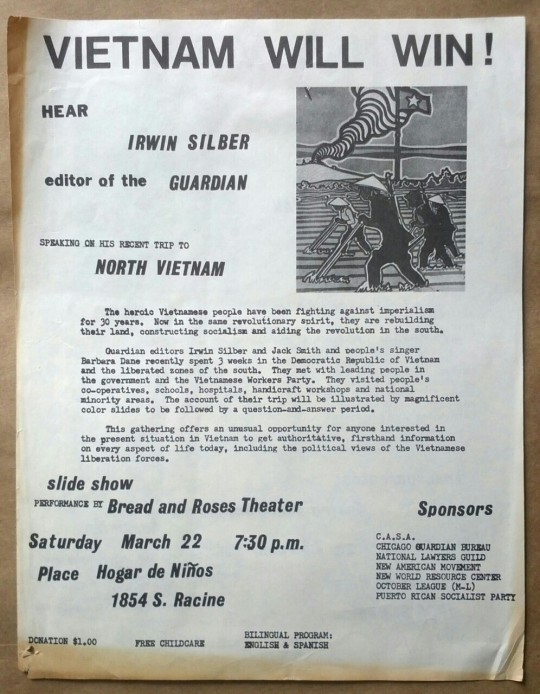
‘Vietnam Will Win! Hear Irwin Silber, editor of The Guardian, speaking on his recent trip to North Vietnam”, Chicago, early 1970’s. Co-sponsored by New World Resource Center, October League, National Lawyers Guild, Puerto Rican Socialist Party, and New American Movement. At that time ‘The Guardian’ was the leading weekly newspaper of the U.S. Marxist activist left.
#the guardian#irwin silber#vietnam#marxist-leninist#new left#new communist movement#1970's#national liberation
15 notes
·
View notes